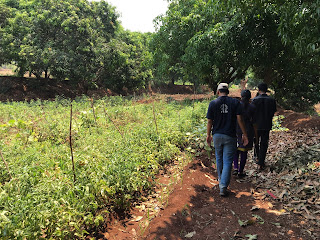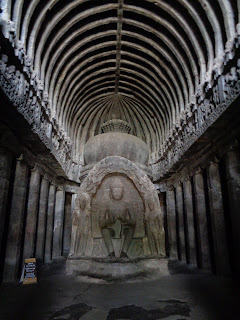Sangrun Village Part 2: May 13 to May 20
On the 13th,
I took a morning walk through the village alone. One of the first chores of the
day is washing clothes; most of the people I saw were women were squatting outside
their homes over buckets filled with clothes and soapy water. I made my way
down to the river via a street I had not walked before; on the way, a man
sitting on his porch offered me to come for tea. I declined politely,
continuing my walk down to the river. As soon as I had passed his house, I
realized I should have (for many reasons) accepted the tea. I returned up the
same street and invited myself in for tea. The man who had invited me to his
home was named Maoli Kaka (Kaka means “uncle” in Hindi) and was picking small
stones out of the rice he had harvested from his field previously. The rice was
still inside its husks; I had never seen rice like this before. Unfortunately I
did not get a chance to see the de-husking machine, which he had inside. We
chatted for a few minutes over tea until I had to go back for breakfast. Our
conversation was in broken English/Hindi, but we understood each other fairly
well. Maoli Kaka invited me to come back to see his farm later in the day.
Aayush,
Aparajita, and I took Maoli Kaka up on his offer later that morning. We went to
his farm and saw the mango trees, eggplant, tomatoes, and other crops he grows.
He picked a green mango from his tree—often used for pickles and chutney but
not often eaten plain—and gave it to me. I munched my way through it and by the
end it felt like I could scrape the enamel off my teeth with a toothpick because
of the acidity. Aayush and Aparajita were impressed that I had eaten an entire
green mango; this may have set a poor precedent, as every time we were offered
green mango in the future, the response was “Tavish loves them” and I was thus
obliged to eat another piece of the sour fruit. Maoli Kaka also took us out in
his boat briefly onto the river; it was even more peaceful out on the water
than in the village—a tough feat, as the village is already very peaceful. In
the evening there was a village-wide celebration for a woman turning 105 years
old. We were a little late to the celebration so did not get to meet the woman
(she went to bed early), but we saw pictures. She looked pretty good for 105!
May 14th
was the weekly street-cleaning day, Sunday. We swept some of the main streets
of the village with about 10 other villagers, including Sarpanch Madam. The
sweeping turnout was lower than I expected, considering Sangrun’s status as one
of the cleanest villages in the region, but the work party was big enough to make
a noticeable difference after about one hour of sweeping.
Later in the
afternoon, we went on a tour of Vijay Kaka’s family farm with one of his
nieces, his son Ajay, and his daughter Rinku. On the way to the farm we ate boiled
peanuts, tamarind, green mango, small “apples” that were not ripe, and some wild
berries with a white gummy interior that we had been served a few days earlier
at Sunil Sir’s house. The salt-water-boiled peanuts were delicious—I wonder why
no one eats them in the US in this form, because they were great. I was still
craving more by the time I finished my handful. The family’s farm is mostly
sugar cane and eggplant. Ajay was proud to show the one small banana tree he
had planted, still many years away from producing fruit. On the way to and from
the farm, I picked up some mineral-filled rocks, of the type that people pay
good money for in museum gift shops in the US, from the basalt landscape. None
of my Indian counterparts were impressed with my rocks. A couple days later,
Rinku came into the GP office to chat with us before dinner. I showed her one
of the geodes I had broken in half using a pipe wrench; her response was not “oh,
that’s pretty,” but instead mimed striking the crystals together to make fire.
Aparajita thought this was especially hilarious. For my Seattle readers, don’t
worry—I am bringing a couple beautiful rocks home from India to put on display.
Varad,
Professor Sardeshpande’s son, arrived on the 15th to stay with us in
the village for a week. He brought a large home-cooked lunch of chole, poori,
and masala rice, sent by his mother. As usual, her cooking was great. The four
of us ate all we could and still did not finish everything. In the afternoon we
had our first meeting with the women’s self-help group to introduce spice
roasting as a possible livelihood activity. We made a small batch of masala
from spices I had bought in Mumbai and looked at the costing of ingredients as
a simple business analysis. Unfortunately, this entrepreneurial activity did
not work out for the village women, but it was a good learning opportunity to
see their reasons for enthusiasm and interest in the activity.
In the
evening, we went out fishing with the family of Sunil Sir’s brother, a couple
dozen small fish in a net. This type of fish is usually used for bait, but
today it was cooked in a stew called russa and served with rice. In addition to
eating these small fish, I was served a couple larger fish (about 6 inches
long) and asked if I had eaten fish head before. The group of 10 or so people
who had gathered in the front room of the house now all watched me intently as I
ate two fish and their heads. The food
was great but the timing was poor; after filling myself on fish and rice, it
was time for a community dinner in the village. We ate a meal with the
villagers, sitting cross-legged and barefoot on the concrete in rows while men
and young boys carried around buckets of food, serving in shifts. This was to
the be first of many days when we ate multiple dinners.
The highlight
of the 16th was watching Sushma Madam and a neighbor cook pooran
poori, a type of Indian bread stuffed with a sweet jaggery-gram flour mixture.
They were mixing the jaggery and gram flour on a flat rock, using another
rolling pin-shaped rock to mash the mixture. In the evening, we returned to try
it—it was even better than it looked during the cooking process. The sweet
bread was served with spicy sabji and with a sweet dipping sauce also made of
jaggery. If I daydream about it, I can still taste the sweet bread dipped in an
even sweeter sauce. This one looks difficult to make, but I might try because
it was delicious.
On the afternoon
of the 17th, Sunil Sir taught us how to catch frogs in the idle
pools at the river’s edge using a stick and a piece of string. We were not successful,
but the challenge was planted in my brain for a later date. In the evening, there
was another community dinner as part of a marriage celebration. At this dinner
was my new favorite dish, bangan sabji (eggplant curry). I generally do not
like eggplant so much, but each of the three times I have had this dish it has
been impeccable. Spicy, flavorful, and served with chapatti and rice.
The last
couple days in the village mostly consisted of continuing to survey households.
These demographic and livelihood surveys are part of the course requirements
for the CTARA village stay and consist of questions related to occupation, land
holdings, power availability, and water use. To conduct the surveys, we split
into two groups—Aayush and Aparajita each took one of the non-IITB students (me
and Varad) to survey households. Varad was a helpful survey partner, as he
spoke Marathi, the local language of the region, and I was simply moral support.
On my last
evening in the village, we again went down to the river to try and catch a
frog. After many minutes of attempts ranging from close to futile, I finally
caught one! As soon as the frog had latched onto the small ball of string at
the end of the stick, I jerked it out of the water. Neither Varad nor I could
grab the small frog before it wiggled its way back into the pool of water near
our feet, but the “fishing” had been successful! We returned triumphant to the GP
office, where the villagers had gathered to give me a gift, a picture of
Shivaji, the famous defender of the kingdom of Maharashtra. The gift was very
thoughtful and the outdoor gathering was a nice way to spend my final evening
in Sangrun. I am very glad I had the chance to meet the wonderful people in Sangrun
and witness their daily lives. I will return to the US with many stories to
tell of what life is like in the village.
In the
morning on the 20th, the four of us piled into the local bus and
headed back to Pune. Aayush and Aparajita were to return to Sangrun in the
evening after picking up some items they needed for their work. Varad and I
took another bus to get to his house, where his mother made us some fresh mango
juice and sent me with a packed lunch to eat on the bus back to Mumbai. After
some confusion on the boarding of the bus, I ended up on an AC sleeper bus with
my own bunk for the ride back to Mumbai—better than the seat on a normal AC bus
I had planned to take! I returned to campus via local train and rickshaw, where
I proceeded to eat a coconut from the fruit stand for dinner and head to sleep
early, exhausted from 10 days in the village.
 |
| Visiting Maoli Kaka's farm |
 |
| Boating with Maoli Kaka |
 |
| Walking around Sangrun with kids |
 |
| Chicken house |
 |
| With Aayush (left) and Ajay at Ajay's family farm |
 |
| Measuring spices for masala making |
 |
| Rowing on the river |
 |
| Picking the small fish out of the net |
 |
| Weighing recyclable material at the GP office (monthly) |
 |
| View of Sangrun from above |
 |
| Ganesh about to hit a lizard with his flip flop |



Comments
Post a Comment